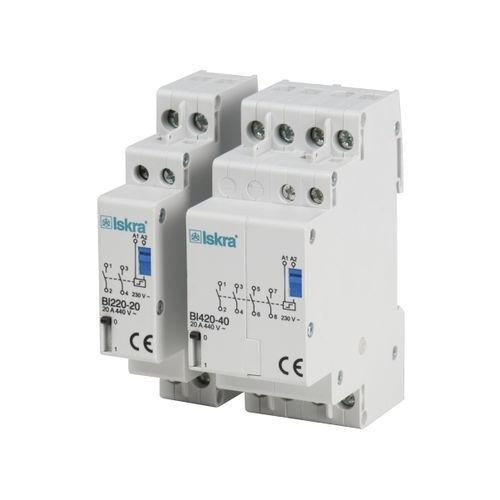
Bistable electromechanical relay DCACpower

Add to favorites
Compare this product
Characteristics
- Control voltage
- DC, AC
- Function
- power
- Other characteristics
- bistable
- Switching current
Max.: 63 A
Min.: 20 A
Description
Latching relays or bistable switches are switching devices with two stable states for switching of all kind of electric loads. Those switches operate without power consumption in operating switch-on position and with a very small consumption per pole.
Are you looking for savings in electric energy? Replace installation relays and contactors with latching relays. At remote switching of lighting, a parallel connection of pushbuttons is used. In this way, a number of conductors is smaller than in a case of connection with cross-point and reversing switches. Because of the pulse control of a latching relay, continuous control current does not flow through the switch coil, which results in a considerable saving of electric energy.
Why Iskra? With years of expertise and innovation we can guarantee you a top quality products with high functionalities at a great price. Customer experiences prove that our switches operate 20% longer than other switches. Switches, made in Slovenia-Europe, are guaranteeing maximum supply reliability, personal safety and preservation of the environment.
Iskra’s switches are suitable for residential buildings, business premises, hotels, hospitals, shopping centres, production halls, warehouses and public places.
Technical data
Small switch on coil consumption
No hold coil consumption
Coil disconnection with selector switch for maintenance purposes
Wide application
Mounting on 35 mm rail
Sealing terminal covers
Catalogs
No catalogs are available for this product.
See all of Iskra d.d.‘s catalogsRelated Searches
- Capacitor
- Switching relay
- Electromechanical relay
- DC electromechanical relay
- Film capacitor
- Power capacitor
- Current capacitor
- Voltage capacitor
- Cylindrical capacitor
- AC electromechanical relay
- Switching power supply capacitor
- Self-healing capacitor
- Power relay
- Industry capacitor
- DC capacitor
- Radial lead capacitor
- AC capacitor
- Latching electromechanical relay
- Electronic capacitor
- Encapsulated capacitor
*Prices are pre-tax. They exclude delivery charges and customs duties and do not include additional charges for installation or activation options. Prices are indicative only and may vary by country, with changes to the cost of raw materials and exchange rates.






